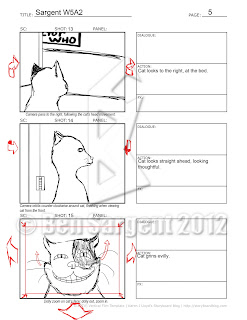Hello again! This time around, we're going to look at creating dialogue and introducing it into a storyboard.
My first assignment for this class was to create a series of 5 different characters of all ages, genders, and lifestyles and try to create dialogue that felt natural to them. Next, we had to create a short scene using mostly dialogue full of subtext, in which characters say one thing but visual cues give the words different meaning. You can find both posted below.
Note: any plagiarism of these stories (for any reason) is illegal and can lead to severe punishment if you get caught. So if you came to my blog just to take my ideas, think twice and try to be creative on your own, because you're only cheating yourself if you steal my work.
Character Dialogue Exercises
Jake Thornton, 4, somewhat precocious, yet childlike in his mannerisms.
- “Hey! That wu-nt vewy nithe.”
- “I dun wanna go to the growthery thtore!”
- “When I gwow up, I wanna be a ath-tro-nut!”
- “Mommy, why do girlth have wong haiw?”
- “I am a supahewo! Cappan Thtwongman!”
Sarina Valdez, 16, bubbly but a little dim.
- “Awmigawd, that was the dumbest class EVARRR!”
- “Like, do you think Mike will ask Rachel to the prom?”
- “You can buy shoes on the internet? Ohmigosh, no way!”
- “I wanna ask Travis to come to my party, but ever since he dumped my BFF it’s been sooooo awkward.”
- “Let’s go to the mall!”
Bryan Peterson, 72, grandfatherly.
- “Just because you’re blue today doesn’t mean the sun won’t shine tomorrow.”
- “Phew, that takes me back!”
- “Kids these days, they don’t get nearly enough sleep.”
- “Tell ya what…if you help me weed my garden today, I’ll take you out for ice cream.”
- “A family and a good pipe are all a man really needs.”
Yvette Umelautte, 33, strict (and successful) businesswoman.
- “Harrison, I want those reports on my desk by tomorrow, no excuses!”
- “I will be meeting with the head of the European branch today. I trust that no one will do anything to tarnish our image.”
- “Clippinger, do you have the files for the Trinity contract?”
- “You have to understand, Michaels…I’m simply looking out for my company’s best interests, and I’m afraid letting you go falls under that category.”
- “If I catch one more person playing Farmville on company time, I will make sure that farming will be all he or she is qualified for.”
Peter Grayson, 22, outgoing, relaxed in his mannerisms.
- “Hey bro! Wanna hit up the club later?”
- “Man, that was a great set.”
- “Awesome! Next round’s on me!”
- “Oh man, I think Sheila’s gonna kill me.”
- “Whoa, I was hammered last night…hey, where’d this tat come from?”
Not-So High School Sweethearts
FADE IN:
INT. BEDROOM – NIGHT
PAUL and SANDY sit on the bed, facing each other. They are hunched over a stack of papers, talking. Paul keeps glancing surreptitiously at Sandy.
SANDY
I just can’t seem to get it! I thought chemistry was supposed to be all about making liquids change color and explode. Why do we have to learn all this math?
PAUL
You’re just making this more complicated than it is. You are a smart girl, you just don’t want to do any work.
SANDY
Well, duh! Why do you think I’m having you help me?
PAUL
I’m not always going to be here to help you whenever you need me, Sandy. And you’ll only be able to rely on your looks for so long in life.
SANDY
Flatterer.
PAUL
Hey, I’m just calling it like I see it.
SANDY
Whatever. Can you at least explain this formula to me?
Sandy points at a page. Paul shifts position to see better, ending up directly next to Sandy.
PAUL
Alright. Let’s see here…
Paul reaches down towards the book, accidently brushing Sandy’s hand. Paul immediately pulls his hand back.
PAUL
You know what, I think we’ve studied enough for the night.
SANDY
What? But we’ve only been at it for half an hour! Besides, we have a test on Monday and I know I’ll flunk if you don’t help me!
PAUL
I know, but if we keep trying to overload our brains with chemistry tonight, we’re less likely to retain it come Monday.
SANDY
I’m starting to think that you don’t actually understand anything on this subject.
PAUL
Your words hurt, Sandy.
SANDY
Whatever. It’s just so frustrating, you know? I try and try to understand this stuff, but it’s like a foreign language. Have you ever faced a puzzle you just can’t seem to solve, no matter what you try?
Sandy picks up her papers and walks out of the room. Paul gathers up his materials and begins to follow, pauses.
PAUL
(quietly)
You have absolutely no idea.
I had a lot of fun coming up with those. So much so that I've been thinking about writing some more. As of right now, though, I don't have much time, so it'll have to wait until life slows down a bit.
Now that I had a sense of how to create dialogue in a scene, next was to add it into my storyboard. This proved to be a bit tricky, as I had intended for Cat Nap to be entirely silent. However, I managed to scrape together some good lines of dialogue, which I will now post.
Like I said, not a lot, but it works pretty well. We're not quite done yet, though. We still need to add some sound effects, music, and a little color!
Until next time.



















































